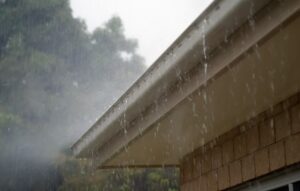Spring is the perfect time to tackle important maintenance tasks around your home. The winter months force you inside, and the summer months are usually packed with activities and events that make it difficult to focus on your to-do list. Spring provides an opportunity to complete important tasks and schedule any repairs that you may need before the weather starts to turn cold again.
Spring also provides the perfect weather conditions for roof and siding maintenance since it isn’t too hot or too cold. If you need the help of a professional, they often experience a lighter workload during this time as well. When it comes to the overall health of your home, it is important to inspect and clean your roof, siding, and gutters. These three elements play a major role in protecting your interior from water damage as well as drafts and unwanted pests.
Spring cleaning tips for your roof
You need your roof to be performing at its best year-round. You rely on your roof to provide structure to your home and protect you from unwanted natural elements. Your roof is constantly bombarded by the sun’s UV rays, debris and dirt picked up by the wind, and general wear and tear that comes with handling the highs and lows of the weather. Spring cleaning tips for your roof include:
· Inspect roof materials. You should inspect your roof multiple times a year, with spring being one of the best times. This helps you spot any minor issues before they can develop into larger issues. Your roof material is your home’s first line of defense against natural elements. Specific inspection checks may vary, depending on the material of your roof. Many homeowners have some form of shingles. Shingles overlap tightly to protect your home from damage, most commonly water damage. You want to ensure that your shingles haven’t suffered any damage throughout the year. You’ll want to look for obvious issues such as missing shingles. You should also check if any of your shingles are curling, stained, blistering, or buckling. These can all be signs of moisture damage that can seep into your home, creating additional damage. If you notice any signs of significant damage, it is important to get a professional roofer in Columbus as soon as possible. They will be able to properly assess the damage and do the necessary replacements to prevent further damage.
· Check seals. In addition to your inspecting your specific roofing material, you should also check any seals along your roof. This could be around vents, skylights, and chimney flashing. Seals are often created through material-specific caulking. You will be able to spot any obvious cracks in the caulking.
· Check for mold. Mold or mildew can grow on the surface of a roof that is retaining too much moisture. If you can see mold, there is a strong likelihood that you may have an issue with proper draining.
· Investigate your attic. You don’t have to climb on top of your roof to check the status of your roof. You can also check the interior spaces that are closest to your roof structure. In your attic, you can check for any water spots, stains, or streaks. You can also pay close attention to any light peeking through or a loose vent. Take the time to explore your home, paying close attention to any stains along with the ceiling or walls. If you notice signs of damage, it is important to contact a professional as soon as possible. This often means that you’ve been experiencing a leak for some time that could be difficult to locate.
· Clear debris. Dirt, leaves, and other unwanted debris can cause damage to your roof. Large debris such as branches can cause significant damage, especially during a high-wind storm. It is important to keep the surface of your roof as clear as possible.
· Trim tree branches. Trees are a great addition to any landscape but can create complications for your roof. You should trim any branches that might hang over your roof. Branches can be broken off from trees, especially in a bad storm. This can add to the risk of debris on your roof’s surface. Trimming branches can help prevent damage as well as potential drainage clogs that can be caused by excessive leaf buildup.
Any maintenance you do to your roof should be done safely. If you can’t safely assess your roof, you should turn to a professional. They will be able to safely access your roof. A professional will also know exactly what to look for when it comes to any potential damages.
Spring cleaning tips for your siding
Your siding protects your home from the elements. It also plays a large role in your overall curb appeal. Your siding can become dirty due to debris and other pollutants, which can make your home appear older than it really is. Tips for siding spring cleaning include:
· Proper cleaning. Siding material varies, and it is important to make sure that you are using the right cleaning method and products for your specific siding. For example, many homeowners choose vinyl siding because it is cost-effective and requires little maintenance. This siding just needs a decent water hose, dish soap, and a scrubbing brush. This helps to remove mold, mildew, and other unwanted stains.
· Power wash. If a traditional hose isn’t able to get the job done, you can consider the option of power washing. If you don’t own one, you can often rent them from local companies. If you choose to power wash, you must ease into the settings. Too much pressure can cause paint to chip or peel, which is counterproductive if you are trying to make your home look good. You’ll also want to make sure you are using the right kind of cleaning products for your siding.
· Check for missing, loose, or cracked pieces. These elements can cause damage to your siding over time. This includes knocking pieces off or making pieces come loose. Parts of your siding can also become broken or cracked. This can expose your insulation and provide a way for not only unwanted weather elements to get in but critters as well. In some instances, you will be able to caulk the gaps to provide a quality seal. In other instances, you may need to fully replace the piece of siding. This largely depends on the type of material used.
· Consider repainting. The sun and other weather elements can fade the look of your paint over time. You may want to use your time in the spring to give your siding a fresh coat of paint. It is important to first make sure that it doesn’t impact any siding warranty and is an appropriate choice for your specific siding. Painting is a cost-effective way to improve the look of your home.
· Keep your grill away. Your siding can be sensitive to extreme temperatures. Many homeowners make the mistake of setting their grill up too close to their homes. This can cause your siding to become discolored or even melt. It is helpful to be mindful of equipment and tools that can negatively affect your siding material.
· Point your sprinklers away. As you start to set up your lawn for the hot summer months ahead, consider how your sprinkler system can impact the health of your siding. Sprinklers can create unwanted moisture issues when aimed too close to your home.
Spring cleaning your gutters
Your drainage system helps to protect both your roof and siding, making it an important addition to your spring-cleaning list. Your gutters can benefit from sporadic cleaning year-round, but especially following the winter months, as they tend to be full of debris and leaves. Any blockage or backup in your gutter system can cause water to pool or seep into your roof, which can cause significant damage. Proper drainage also ensures that water is moved away from the siding.
You should start by cleaning all visible debris throughout the gutter system. Once that is clear, make sure that your downspout is also clear. You may need to use a hose or plumbing snake for hard-to-reach areas. Make sure to check for any sagging, holes, or other damage when cleaning your gutter system. A properly maintained gutter can help you avoid significant water damage that can impact both your siding and roof.
Trust in the professionals
Spring is a great time to assess the exterior of your home, especially your roof, siding, and gutters. Consistent inspection can help you spot any issues that could impact your home and your wallet. Water damage can create significant problems for both the interior and exterior of your home. This damage often finds its way in through gaps in your roof or siding. Your gutters can also contribute to the overexposure of water if clogged. If you notice any issues or are unable to make a close inspection due to safety, you can trust the professionals at Able Roofing. We can assist you with any problems concerning your home’s exterior — contact us today!









